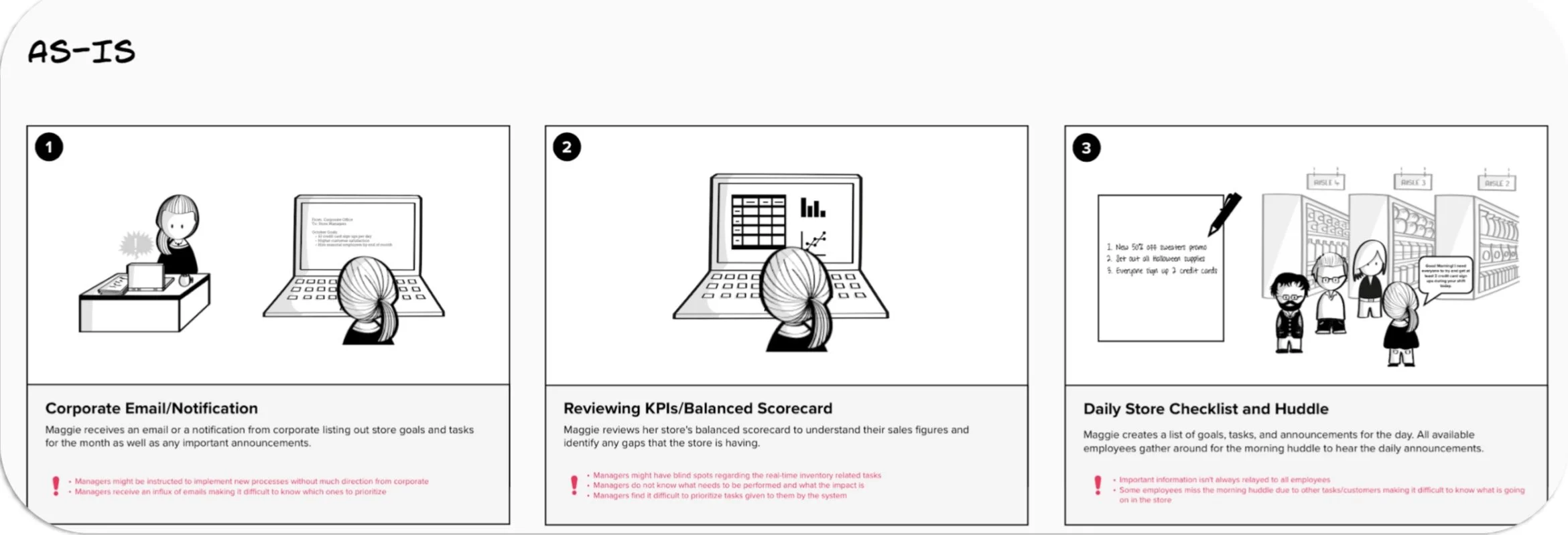Store Productivity Management
CATEGORY
MOBILE & DESKTOP APPLICATION
DURATION
3 MO
YEAR
2021
FEATURE OVERVIEW
ROLE
TASK
RESPONSIBILITIES
Discovery Phase
Conducted user interviews and design thinking workshops to build personas and better understand user pain points
SAP’s Retail Store Productivity Management project focuses on assisting retail store managers better understand store performance and delegate re-prioritized tasks to store associates.
Lead product designer
Lead design efforts in creating an Android mobile application to assist retail stores in tracking store productivity
Recruit participants through Respondent, conduct 40+ hours of interviews and design thinking workshops, refined product requirements and product vision with my product manager, designed low to high fidelity mocks, iterated on designs based on customer feedback, acted as the point of contact for all UX related questions.
The Process
Lab Phase
Created high fidelity mocks to showcase multiple solutions to solve the problem space
Iterate
This step was handed off to another designer once I left SAP
Market Release
Alpha release for this product was planned for early 2022
Project contextDiscovery phaseAfter re-aligning on what we wanted to do with the product, we entered the discovery phase again where we reran workshops with retail store managers.
lab phaseWe had a strong understanding of where our product could provide value once we entered lab phase allowing us to jump right into exploring various concepts.
Iteration & Market releaseThese two steps were completed once I handed the project off to another designer prior leaving SAP.
Innovation within SAP
As part of the SAP Innovation Center team, SAP’s Newport Beach office has teams focusing on defining retail industry problems and creating innovative solutions specifically within the retail planning and execution space. The Retail Store Productivity Management project is part of an effort to assist retail stores run more efficiently through better store activity tracking and task management. During my time on the team, I assisted the lead designer in building designs using SAP Fiori and Material Design Android guidelines and validating concepts through user testing and design thinking workshops. After some time, I was given the role of lead designer and with that role led design efforts for the project’s shift in concept.
Re-defining our Product
After running multiple 3 day workshops, we noticed that a key pain point for store managers to efficiently assign and re-prioritize tasks is the lack of updated data. There were a lot of unknowns around what problems were happening in stores due to delays in receiving data. We identified this as a potential opportunity where our product could provide real value. Some of the standout quotes from our sessions are listed to the left.
Following the sessions, we created an As-Is user flow to consolidate all the feedback and pain points to start ideating on solutions to help alleviate common frustrations. After brainstorming sessions, we created a To-Be flow of how our users will go about their tasks while using our product.
We currently don’t have any tools to provide us with real-time data on how our store is performing.
I constantly have to pull labor from other departments to pick up slack on tasks that aren’t complete.
Research Outcomes
The primary learnings coming out of the discovery phase were:
There is a need for a systematic way to reprioritize tasks throughout the day.
There is a want to have higher visibility to the value associated with each task.
More transparency with store and department priorities are needed to accurately assign tasks to store associates.
Defining a Workflow
Following the discovery phase, we created an artifact to jot down our ideas for each step in the general task assignment flow. This allowed us to start riffing on different concepts and led to creating high fidelity mocks to start gathering feedback on. We created a few mocks to showcase our ideas and conducted initial interviews with customers to gather feedback on the general direction the product was headed in.









